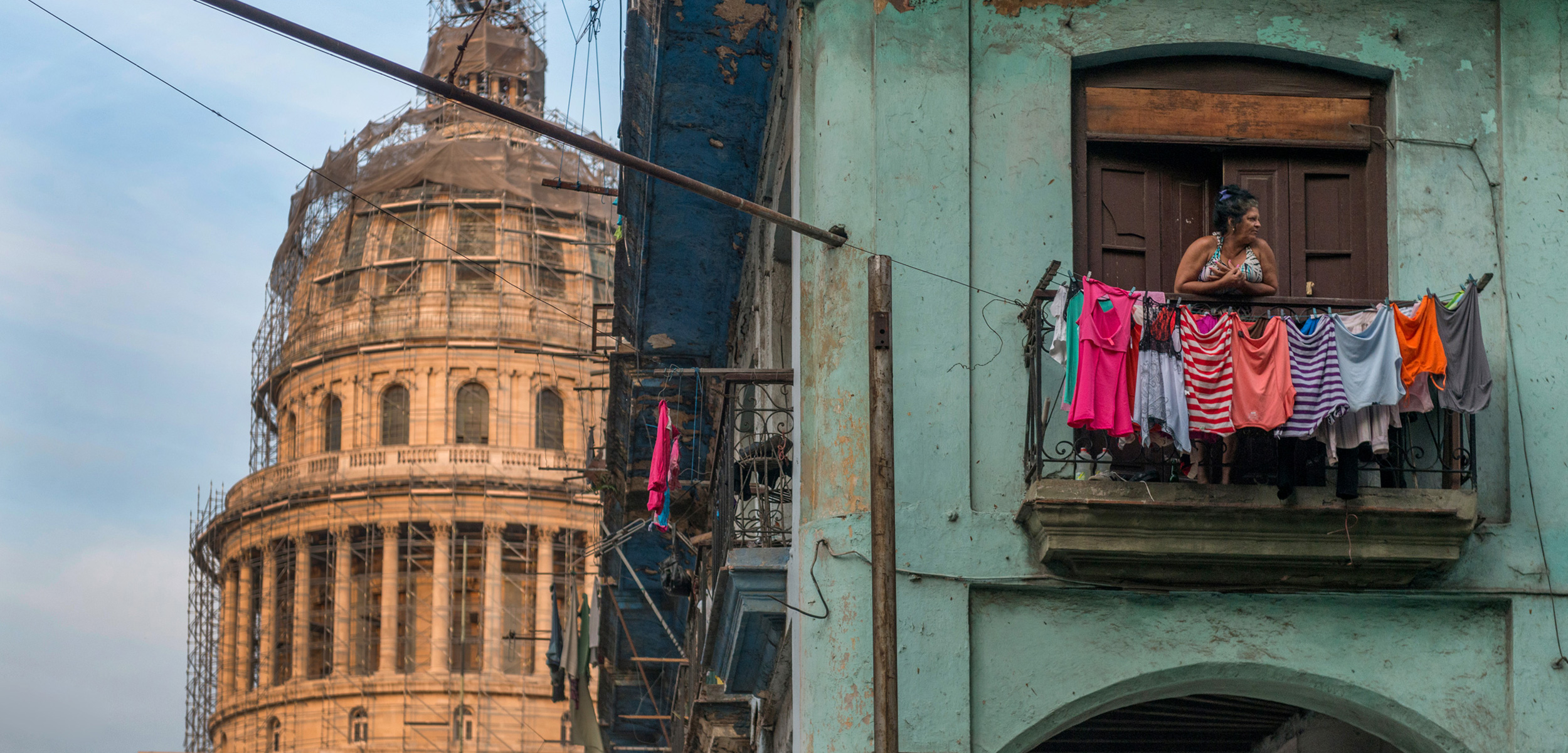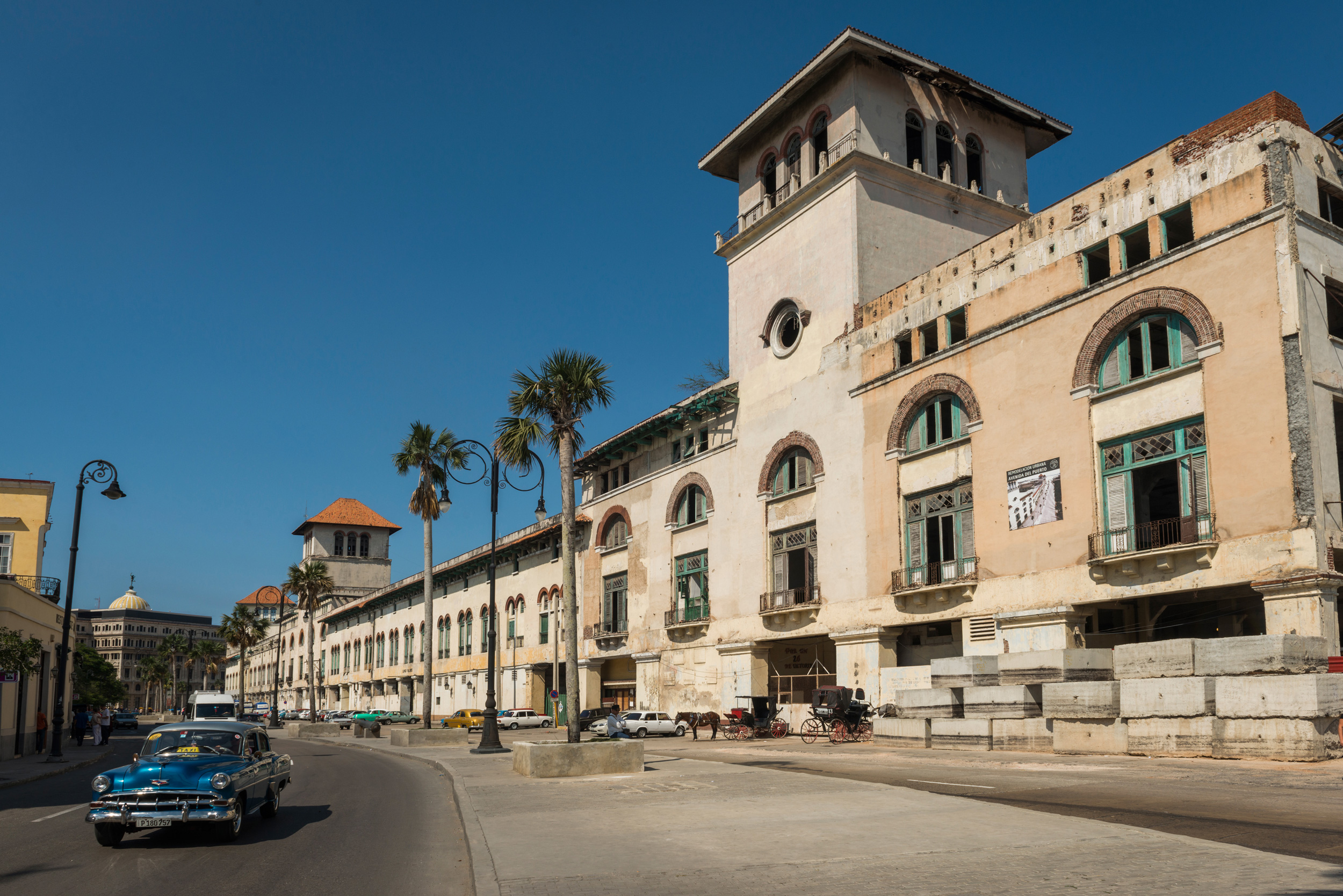Havana: Some Assembly Required
A communist city struggles to lure foreign money and rebuild its failing infrastructure without sacrificing its revolutionary roots.
Article body copy
If a place could be described as bitterly hot, it’s here on a street along Havana’s waterfront. A century-old custom house sprawls the length of three soccer fields, blocking the sea’s cooling embrace. The building is an affront—a dilapidated fortress with broken windows and gaping holes in its terra cotta roof—that I deeply resent right now.
I’m on a walking tour with two dozen international architects and urban designers, as we imagine a theoretical future for Havana. The walk is part of a charrette—an exercise that gives professionals and community members a voice on urban development when there is no formal mechanism to do so, as has been the case in crumbling Havana. At this moment, however, under the searing sun, it’s our imaginations that are crumbling and the water that’s theoretical. Every so often, the scent of sunscreen permeates the air as someone slathers it on their glistening pink face. “Agua?” we inquire, as we poke our heads into doorways on a fruitless search for bottled water.
As relentless as the heat on this “death march”—to quote the mutterings of the design contingent—is our leader: Cuban-born architect Julio Cesar Perez, clad in a heavy blue blazer and exuding a kind of reptilian comfort. His taut, olive skin is radiant under the tropical sun. Like a lizard animated by the heat, he whirls around, pointing this way and that way, and expounding on the failings of this once great city—the largest metropolis in the Caribbean, with a population of over two million. Havana is Perez’s birthplace, his stomping grounds, and his part-time home when he’s not in Miami, Florida.
Unlike the rest of us sun-numbed dolts, his brain gallops around the problem of the behemoth blocking views of the sea and its cooling breeze. Perez barks out a solution: hollow out the ground floor of the custom house, tear off the exterior walls, and liberate its bones, the structural supports. I can almost feel the rush of fresh air. “The bay is Havana’s most important geographic feature,” Perez booms. “Geography is what allows cities to be born!”
Since 2007, Perez has led multi-day charrettes to sketch out a future for the long-neglected neighborhoods of Havana, with the goal of compiling a holistic plan for the entire city. His vision focuses on the people. He sees a walkable metropolis—with a green belt of parks and plazas—that maintains the city’s historical character and Caribbean vibe, while providing new opportunities for affordable housing and economic growth. He shares the findings of each charrette with government officials, hoping the ideas will eventually infiltrate the master plan for the city. By contrast, a Barbados-based developer has submitted a Vegas-style harbor development proposal to the government, describing hotels, shops, an open-air park, and an outdoor theater featuring a gymnastic spectacle à la Cirque du Soleil. It’s just one of many ambitious proposals from foreign developers eager to claim a slice of Havana, but so far, the government has been mum about which direction it’s leaning.
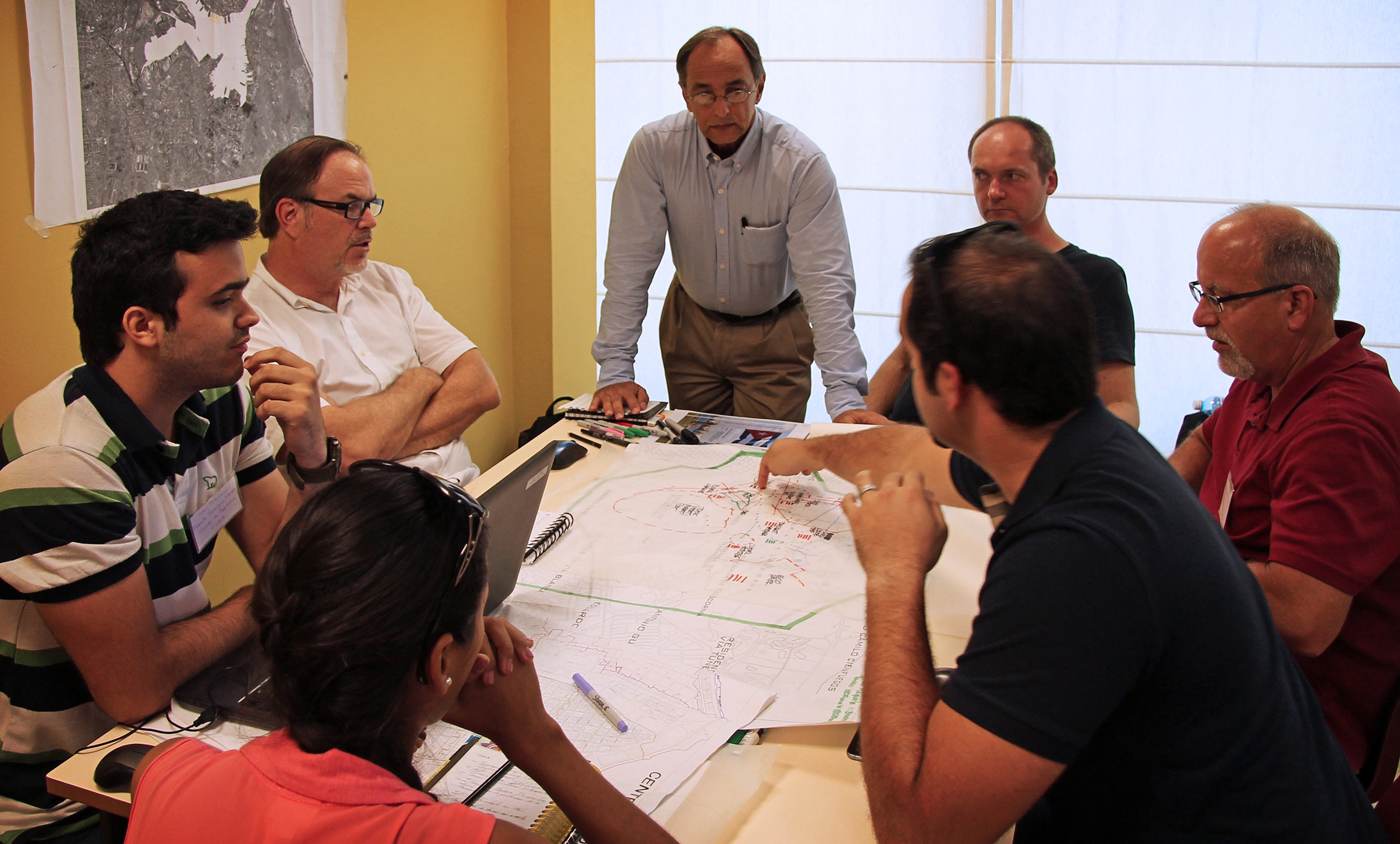
For nearly a decade, Cuban-born architect Julio Cesar Perez (standing center) has been leading charrettes, which are workshops that give professionals and community members a voice on urban development. Here, he reviews ideas from international architects and urban designers for the neglected neighborhoods of Havana. Photo by Brendan Borrell
What’s at stake in these competing visions is how urban revitalization will unfold and who will benefit from the changes to this storied coastal city, swathed in socialism and relatively isolated from the international economy. As the Cuban government slowly loosens restrictions on private enterprise, one wonders if the gentrification of Havana is inevitable.
After continuing our walk along the Alameda de Paula, an 18th-century promenade, we come to a dockside brewery that the government opened in 2014 inside a warehouse once used for wood and tobacco. Its industrial aesthetic seems to have been plucked from the “hipsterfied” neighborhoods of Vancouver or Brooklyn, and at US $5 for a skewer of chicken and a couple more bucks for a beer, the prices are still out of reach for locals, whose government salaries net them less than a dollar a day.
Perez, a former architecture professor in Cuba who now teaches around the world, points out a windowless Rubik’s Cube of a building that’s part of the brewery complex—another obstacle blocking the waterfront. It houses electrical equipment. For what? I have no idea, and I’m not sure Perez does either. But he is appalled that the government architect charged with renovating the brewery had thought so little about the people of Havana—the Habaneros—who use the city each day. “It’s the same mindset, the same stupid mentality: ‘I want to leave the print of my time,’” he huffs with dramatic flourish. “There’s no value in that! That could be done by a child! If I had a student who did that, he would be flunked.”
He pauses and looks out at the group, the make-believe designers of the city. “The good news is we can easily demolish it. And we will. We will.”
Havana has always been a place where dreamers like Perez saw their chance to change the course of history.
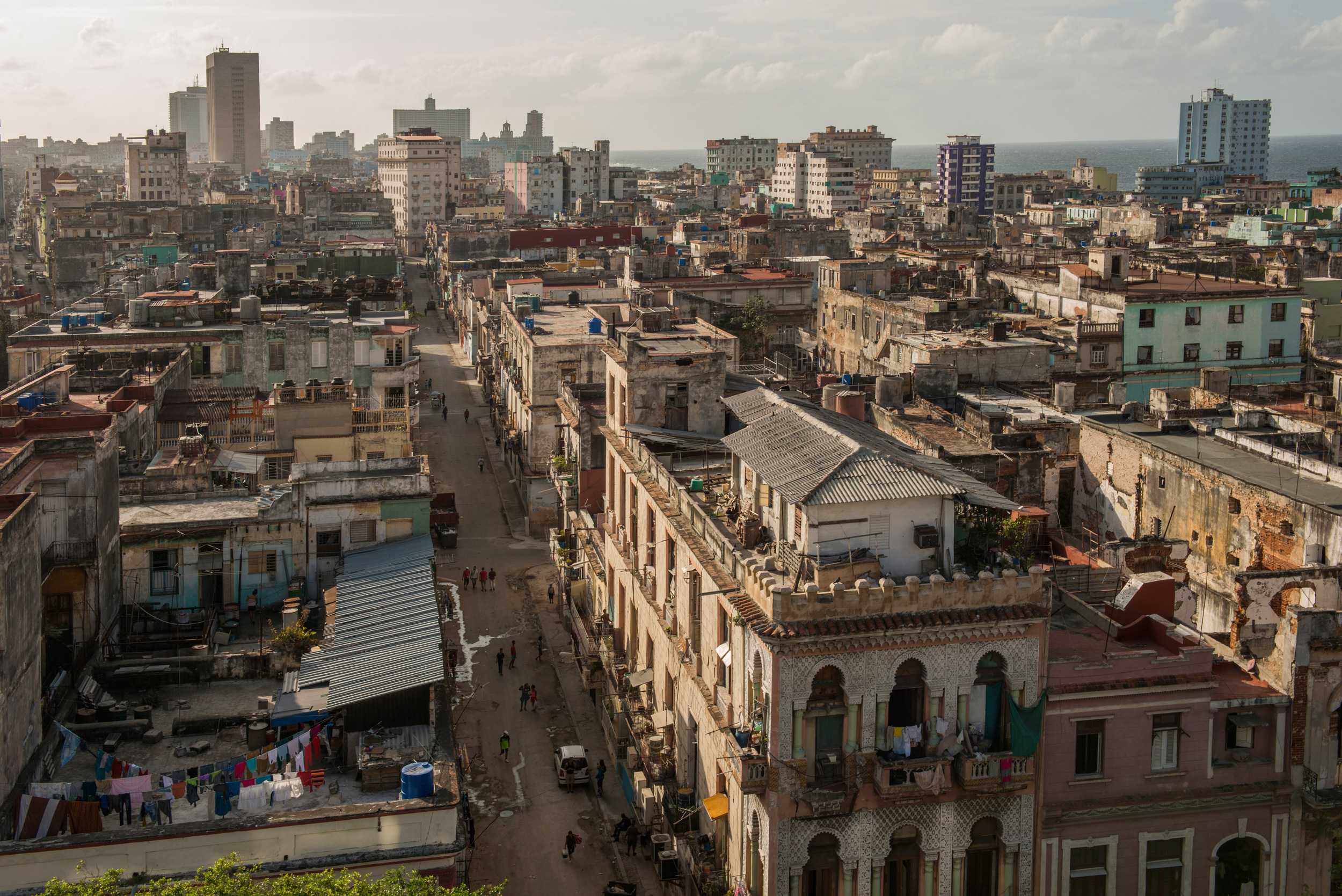
The inner-city neighborhood of Central Havana has some of the city’s worst living conditions, with an estimated 40,950 people per square kilometer. Photo by Hakai Magazine
In 1515, well into the European exploration and exploitation of the Americas, Havana’s natural harbor and access to the main shipping route between Europe and the Americas drew the Spanish to its shores. For the next four centuries, the city grew in size and in architectural wealth. Havana contains some of the finest examples of architecture in the Western Hemisphere, such as the baroque coral rock facade of the Cathedral in Old Havana and the Belle Époque mansions of the Vedado neighborhood.
Unlike other cities of the same vintage, Havana’s ravine-like alleys were never remade by the automobile-obsessed urban planners of the mid-20th century. It’s as though the place was stashed in a time capsule not long after January 1, 1959, when Fidel Castro and his band of revolutionaries took over.
In the early days, the Cuban government, for the most part, focused its efforts on agrarian reform in the countryside, leaving Havana and other cities on the island to deteriorate. One of the government’s most heralded reforms, however, was declaring housing to be a universal right. It halted evictions, slashed rents in half, and reduced electricity rates, which were among the world’s highest. “The people rushed into the streets rejoicing, as they would in any country, even here in New York, if rents were reduced by 50 percent,” Castro boasted in 1960 during his infamous hours-long speech at the United Nations.
The Cuban government seized and redistributed billions of dollars of property from foreign companies and individuals along with that from Cuban exiles, whom Castro deemed gusanos (worms) for fleeing the revolution. Under the Urban Reform Law of 1960, the government converted most tenants to homeowners or provided them with affordable lifetime leases. To prevent speculation, people could own one primary residence and one vacation home. In Havana, state employees were allowed to take time off work to construct new dwellings for their colleagues and community members. Castro believed the revolution would change what was “a land without hope, a land of poverty and illiteracy,” into an advanced and developed nation—and housing was an important component in that vision.
Restrictions imposed at the time effectively shut down the real estate market, and most Cubans wanting to move had to swap their homes for another of equal value. By the late 1990s, more than 85 percent of Cubans were paying little or nothing for their homes, though residents were often stuck living in the homes they grew up in long after they married. One-on-one home swaps were naturally inefficient and some families ended up with too much space while others were crammed into a single bedroom. Because of this lack of mobility, gentrification—the process in which outsiders move into desirable areas and displace locals as real estate prices rise—has been inconceivable in Havana. Yet over time, Havana’s infrastructure and housing has decayed, a process accelerated by the salty air and tropical storms, and the Cuban government has rarely had the means to repair it.
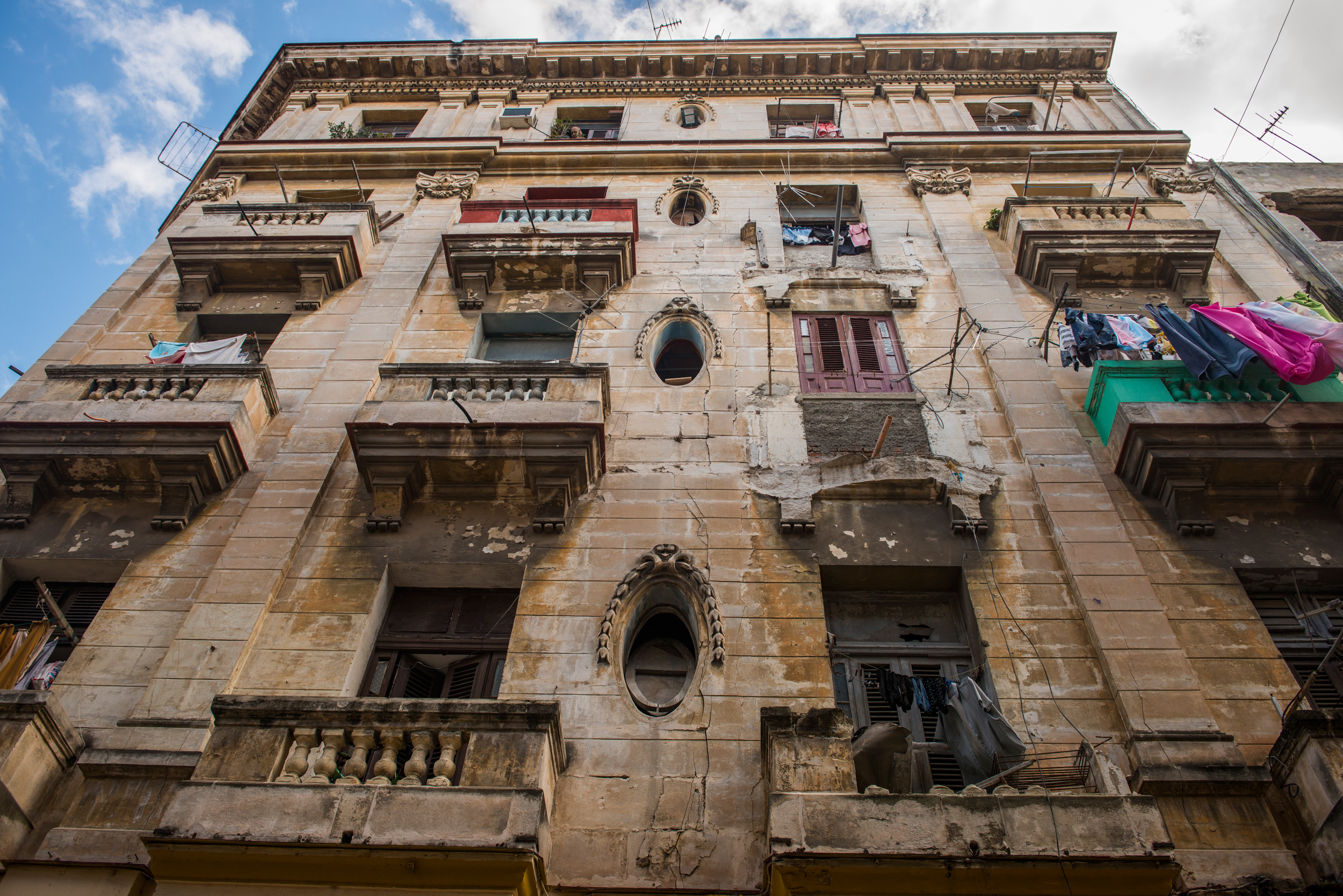
Old Havana is filled with decaying buildings such as this one, with its missing balconies and a deteriorating facade. Photo by Hakai Magazine
After Raúl Castro assumed the presidency in 2008, the country gradually began a process of economic liberalization, known as the apertura (opening). By the end of 2011, a wide range of Cubans around the country were opening restaurants and bed and breakfasts, which has allowed them to benefit from growing tourism and keep money circulating. The apertura also relaxed communist restrictions on the buying and selling of property. The changes Cubans are making to their homes as a result could help shore up and beautify the city and raise the standard of living. But aside from a few overpriced government offerings, such as the Atlantic condominium tower, a joint venture between the Cuban government and an Italian firm that opened on the waterfront in 2007, nonresident foreigners are barred from the new market and haven’t been able to swoop in and price out Habaneros. The restrictions have, in other words, continued to put the brakes on gentrification.
All development in Havana remains closely regulated by the government. Most large-scale construction—including the potential redevelopment of the waterfront—is controlled by a sprawling business empire owned by the military, and permits for new buildings can take years. Even projects at more modest scales, such as home renovations or restaurants, are supposed to be designed by government architects—although many skirt the law. Neighborhood leaders who make up the Committees for the Defense of the Revolution—a kind of spy network Fidel Castro established to monitor dissidents—also have some power to approve or forestall projects in their area. With these structures remaining in place to guard against the negative aspects of gentrification and uncontrolled development, it’s clear the city’s leaders will be straddling the line between encouraging foreign interest and not betraying the central tenets of the revolution.
For the people of Havana, the free market is also a gamble. Habaneros finally have an asset to leverage, and they must decide at what price they want to cash in on their domestic security for the chance to pursue their dreams. Such existential dilemmas play out every Saturday morning at Paseo del Prado, a tree-lined promenade that runs from the waterfront to Central Park and serves as a makeshift real estate marketplace. When I stop by, dozens of sellers are standing around with cardboard signs describing their properties. Brokers and real estate agents cluster in groups or plant themselves on benches with binders full of photographs.
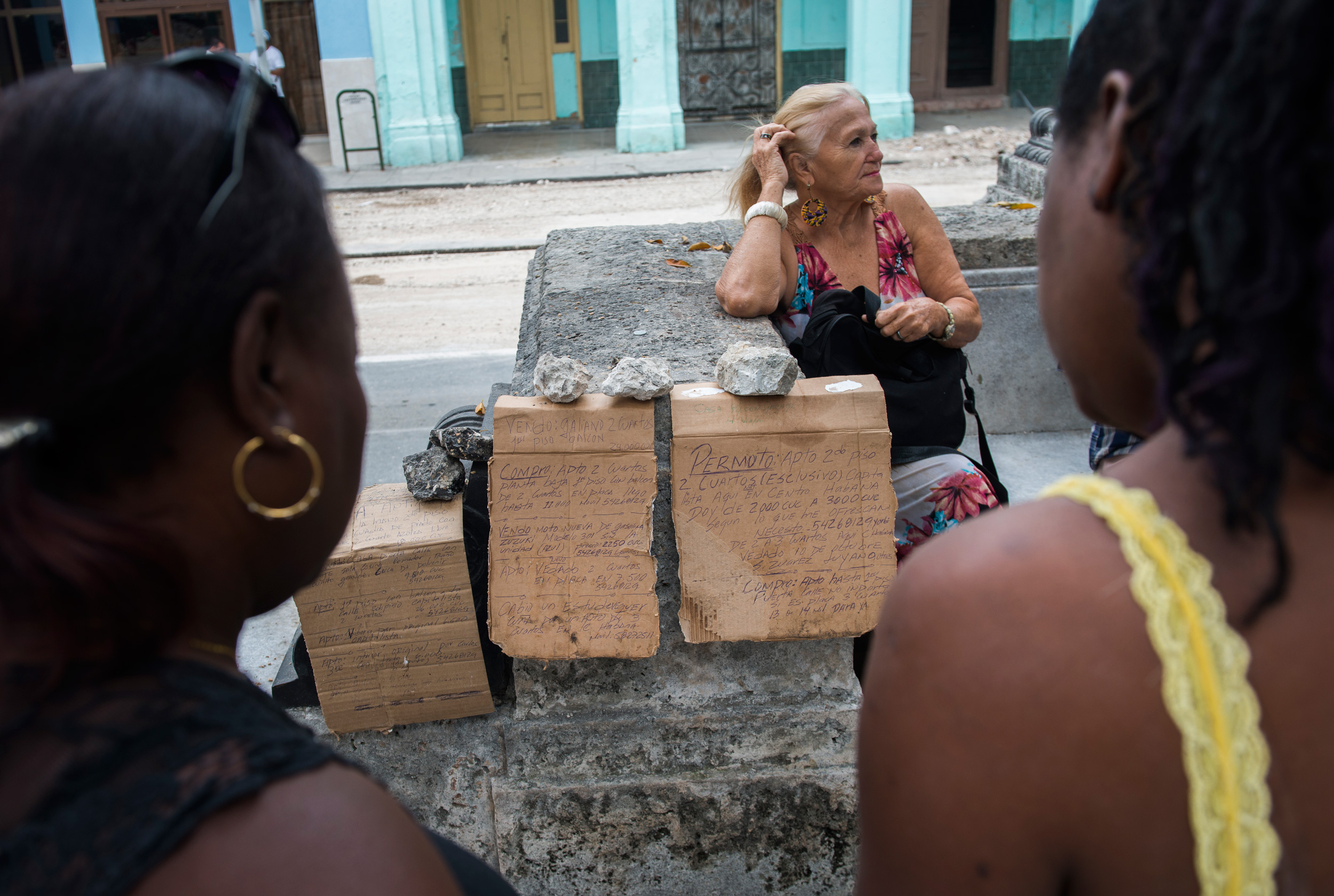
A resident tries to sell or trade her apartment at the informal real estate market that takes place every Saturday along the Paseo del Prado in Havana. Photo by Hakai Magazine
Some complain that the internet is eating into their business; they preferred the kickbacks they got when the housing swaps here were underground and untaxed. Others try to interest me in their offerings. It would be relatively easy, they say, for me to find a Cuban woman to marry and put her name on the paperwork. With mortgages still unavailable from banks, these transactions are sometimes conducted with suitcases of cash. The only way Cubans have that kind of money is if they sell their own homes or have friends or family wiring them money from abroad.
“Unfortunately, many people are selling and few are buying,” says hopeful seller Rolando Pino Rosales. With his red tank top and mop of long, curly brown hair pulled back under a headband, he looks like the host of a 1980s MTV program. Around his neck hangs a giant gold R pendant, and the cardboard sign paper-clipped to his shirt says “For sale or swap.”
Rolando has been coming to the market for the past four months, trying to find a buyer willing to spend CU 30,000 (about US $30,000) on his four-bedroom home in the historical sector of Old Havana, but he is also willing to swap for a smaller home and cash or a car. He pulls out his phone and shows me a video of the meticulously restored interior. “I want to travel and work somewhere like Panama or Ecuador,” he says. The question is, what will be left for him in Havana if and when he returns.

Rolando Pino Rosales holds up the cardboard sign he has been using to try to sell or trade his apartment, which he has carefully refurbished, in Old Havana. For the past several years, Cubans have been allowed to privately buy and sell properties. Photo by Hakai Magazine
In the near future, the strongest factor that will shape the lives of Habaneros will be tourists and their bulging nylon money belts. In March, US President Barack Obama made a historic visit to Havana, after relaxing some restrictions on travel and commerce in Cuba and reopening the embassy for the first time in 54 years. If the US Congress lifts the trade embargo on Cuba, the International Monetary Fund has estimated that the island will be awash with as many as 10 million American tourists each year, arriving on cruise ships, sporting Tommy Bahama shirts, and puffing on Cohiba cigars.
As a tourist, I’ve always felt uncomfortable about visiting a country poorer than my own; I find myself trying to tread the line between feeling like I’m an exploiter and feeling like I’m getting ripped off. Havana, more than any other place I’ve been to, presents itself as two cities folded into one—a Havana for the locals, another for tourists. It feels like you’re shelling out an entry fee to step inside its borders and gawk at the locals and their jury-rigged Cadillacs.

Students walk along Havana’s harbor, past restored vintage cars operating as taxis that are awaiting guests from a floating restaurant and a cruise ship—indicators of the city’s changing character. Photo by Hakai Magazine
It wasn’t always this way. For the first 30 years after the revolution, the Cubans had a benefactor in the Soviet Union, which propped up the economy and funded social programs. During the Soviet economic collapse in the 1980s, the Cuban government, for the first time, sought to cash in on Havana’s architectural heritage through tourism. With a kind of capitalistic fervor, the City Historian’s Office, which is responsible for Havana’s architectural heritage and is led by a man named Eusebio Leal, established a state company in 1994 called Habaguanex. The enterprise includes restaurants, hotels, museums, and even a perfume shop in its holdings. Habaguanex generates more than $20-million in profits each year, half of which is directed toward social projects and half toward restoration work.
Although Habaguanex’s work has prettified Old Havana and regulated renovations on building exteriors, it has also created what critics have called “tourism apartheid.” While foreigners stay at lushly restored hotels, nearby locals are living precarious lives. The state has never kept up with the housing needs of its population; during the late 1970s, one-third of construction around the country was unofficial, built by locals without expertise or access to proper building materials.
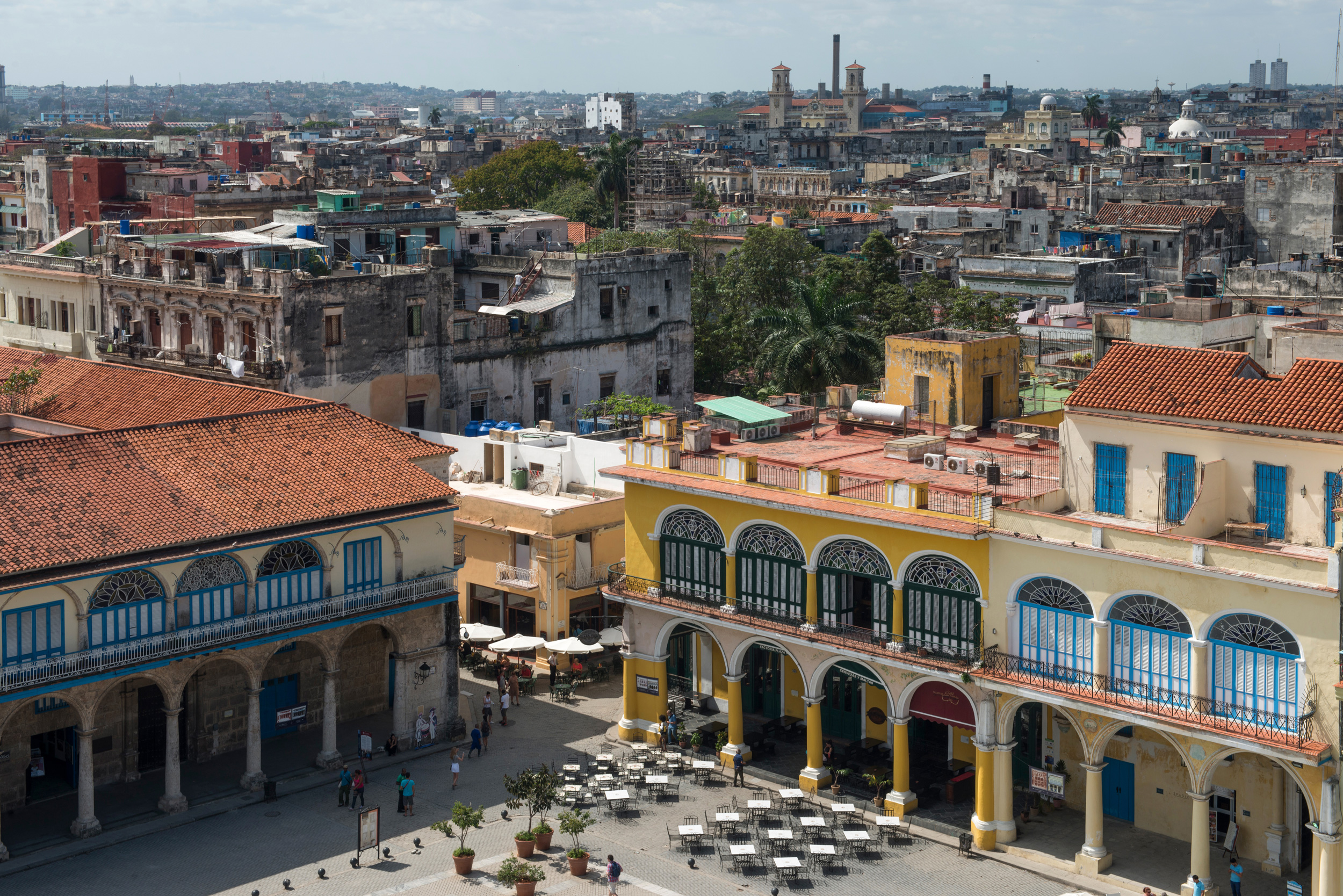
The beautiful restored facades of Old Square in Old Havana are a stark contrast to the rest of Havana. Photo by Hakai Magazine
Residents of El Fanguito (Little Swamp), a shantytown on the banks of the Almendares River, for instance, suffer annual floods, and some of the older residents have fought for more than 50 years for title to their makeshift homes. It’s one of many shantytowns that were springing up at the time of the revolution, filled with migrants from other parts of the country. Locals say the government has never recognized their right to live there or followed through on promises to build replacement housing.
Established neighborhoods where residents do have rights to their homes are sometimes just as dire. Central Havana has few streetlights, giving the place the chiaroscuro quality of a film noir set. A taxi driver once advised me to walk in the middle of the street, rather than on the sidewalk, to avoid detritus falling from buildings. In the early 2000s, according to a report from the United Nations Development Programme, Old Havana experienced two building collapses every three days. Many people now live in albergues, which are basically shelters for people whose houses have fallen apart.
The city’s reawakening is revealing just how fragile its skeleton has become. At 6:40 a.m. on July 15, 2015, a man named Rafael Alvarez Paez was lying in bed in his second-floor apartment when he woke to a rumble. He was 42 years old, but—like many Cubans—he still lived in his mother’s home, which was just steps away from Calle Obispo, the Disneyfied tourist corridor with old-timey pharmacies and shops selling vintage posters of Fidel Castro and Che Guevara. His family was sound asleep.
Suddenly, Paez felt the floor drop beneath him, and then he was buried. The entire house had caved in, and a beam pinned him at the waist. “Help me!” he screamed. By the time rescuers cleared the debris, they found four dead bodies: Paez’s mother, his daughter, his nephew, and his nephew’s girlfriend.
Paez tells me this story when I track him down at the end of Calle Aguacate, where his new home stands out from the decrepit buildings next door, due to its fresh coat of baby-blue paint and oversized wooden door. Inside, the house is sparsely furnished with an old couch and a few rocking chairs around a blaring television. In the front room, a blue Santeria altar honors his mother’s saint, Yemaya, the mother of the seas, who is represented by a doll with oversized hoop earrings.
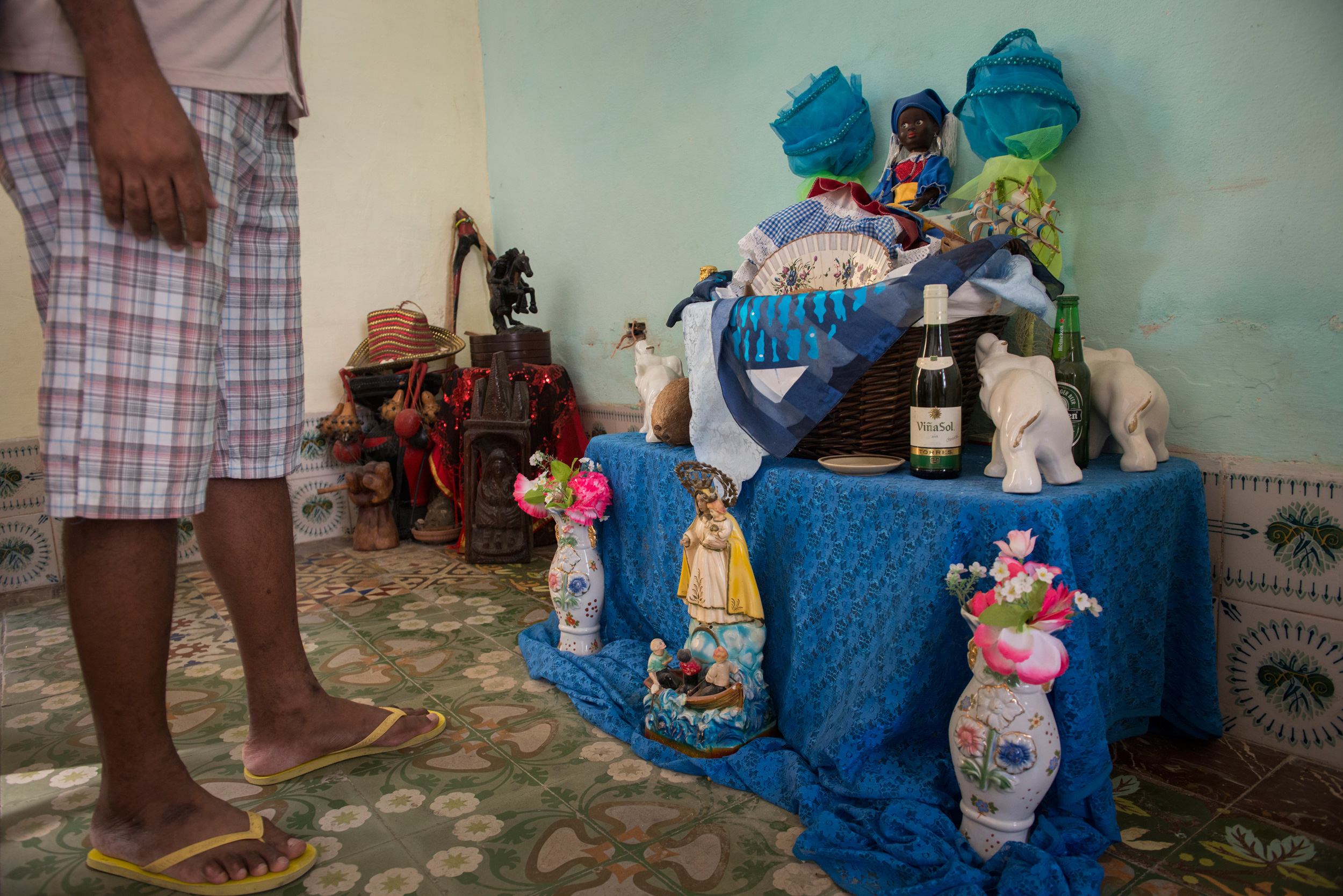
Rafael Alvarez Paez maintains an altar honoring his mother’s saint, Yemaya, in a corner of his new living room. His mother and three others died when Paez’s last home collapsed. Photo by Hakai Magazine
Paez slouches in one of the chairs by the front window and recounts the events with an air of detachment, but I can tell from the way he avoids meeting my eyes that the memories are painful. He feels that the world should know his story. His wife, who had to have her knee replaced and is awaiting cosmetic surgery to remove scars from her face, refuses to come out from the kitchen to meet me.
It’s unclear exactly what caused the collapse, but Paez says that a Cuban-Italian man had recently purchased the space on the ground floor and was remodeling it to open a restaurant. Workers removed one of the walls, and, according to the official state newspaper Granma, the legality of the construction is under investigation. If the allegations are true, it reveals the dark side of the renovation boom in the sector of the city with the greatest tourism potential. “All of my memories are from the house,” he says. Unchecked development, he adds, “is a serious problem in Havana.”
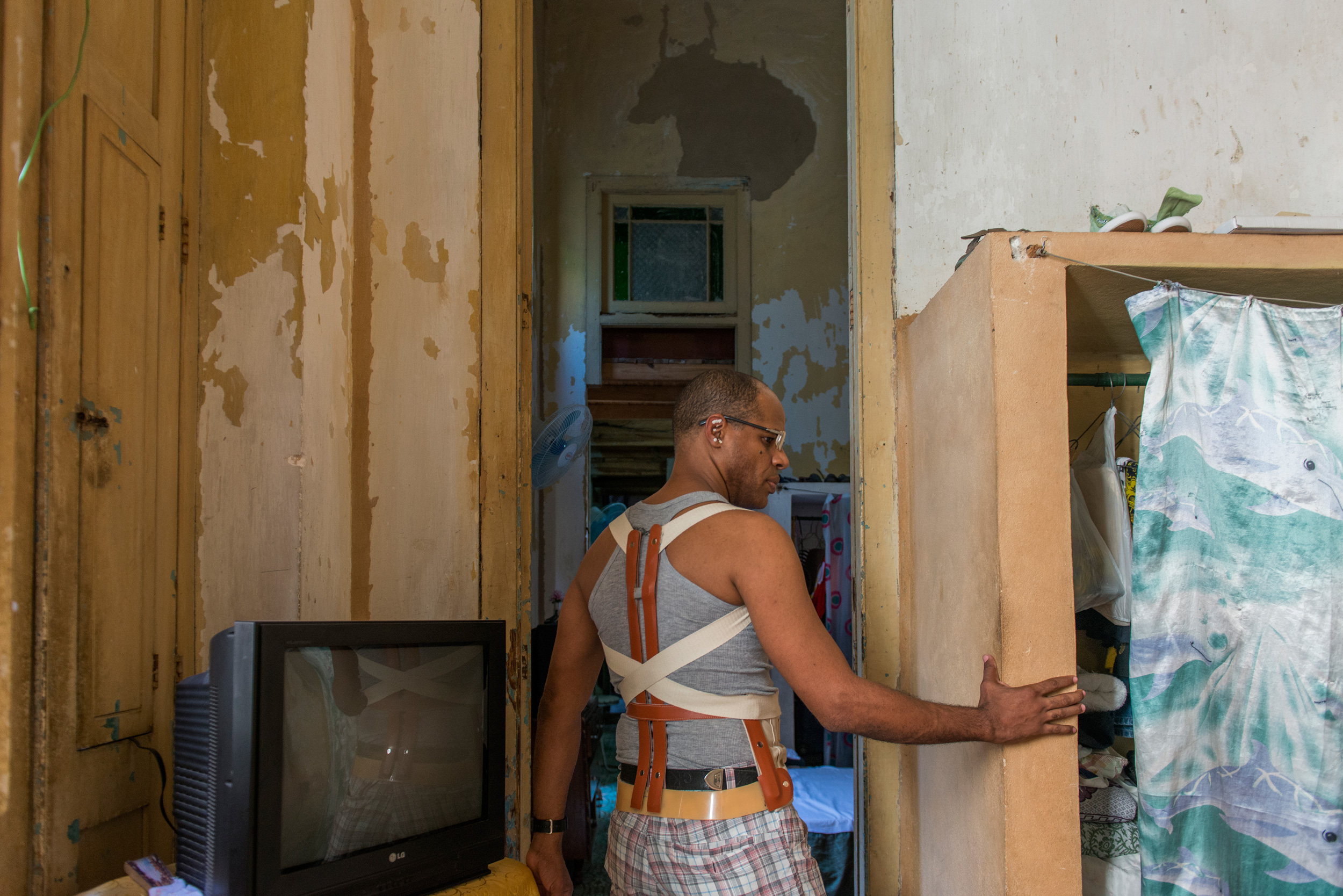
Rafael Alvarez Paez’s back was injured when his last home collapsed. He uses a brace and is taking acupuncture (the white points on his ear) to deal with the pain. Photo by Hakai Magazine
On the final day of Julio Perez’s charrette, the designers take seats on pews in the San Carlos Seminary—an 18th-century building that now serves as a Catholic cultural center—to present ideas that range from the practical to the far-fetched. One group imagines extending the Paseo del Prado promenade beyond the capitol building, down to the railroad station on the harbor. Another group suggests creating a series of barges that could dock on the waterfront and provide amenities, such as a pool and recreation center, to locals. Hector Gomez, an architect from the City Historian’s Office who attends on his own time, finds the proposals captivating. “We don’t have the money to implement these ideas, but we have the time to dream,” he says.
Today, parts of Havana have become perpetual construction sites with small cement mixers propped up in the streets outside of private homes and scaffolding wrapped around historical buildings in Old Havana where Habaguanex is funding restoration. When I peek into one gutted apartment in the Vedado neighborhood, I am told a Frenchman is ripping out the original tile floors to replace them with marble. He could be married to a Cuban woman or else have a friend or lover listed on the property title.
You can’t visit Havana without noticing that something big is happening, but the question is, what name do you put on these changes. They may be precursors to more dramatic shifts to come, the first rumblings of the beast we know as gentrification, but the government has hardly abandoned its socialist goals. “It’s wrong to characterize what’s going on as this whole free-market transition where people are left on their own,” says Martina Kunovic, a social scientist from the University of Wisconsin-Madison who studies the Havana housing market. A point of pride for the government is that Havana’s neighborhoods remain racially and socially diverse, and she believes that there will continue to be limits on foreign investment. “While the government is trying to secure the economic prosperity of the country, they are not willing to give in under all circumstances.”

Workers paint the facade of the Oratorio de San Felipe Neri building in Old Havana. Once a church, then a bank, it is now a concert hall. Photo by Hakai Magazine
The restrictions Cuba maintains on investment, private enterprise, and property ownership will slow the process of stratification among its people, but Habaneros, enterprising and ambitious, remain motivated by the idea of a more prosperous future. Their modest businesses, once hidden, are now allowed to blossom—within limitation—and may even safeguard the social safety net that the revolution once promised. “Practices that had been going on for years are finally being made legal so that the government can capture some of the taxes,” Kunovic says.
At the bed and breakfast where I’m staying, owners Jorge and Lazara Pastor are taking the transformation one day at a time. “The house has allowed us to live a little better, but we will never be rich,” Lazara tells me one morning over breakfast. The income has allowed the couple to occasionally go out to their favorite restaurant and for Lazara to save up enough money to visit her daughters in the United States. Without the extra money from renting her home, she would have left the country, moved in with one of her daughters, and worked as a housekeeper. “The apertura has changed our mentality regarding emigration,” she says.
As if on cue, a man in a yellow T-shirt carrying a messenger bag arrives at the front door. He is from the National Tax Administration, and he has come to notify the couple that their taxes will be increasing next year. They are making too much money.

